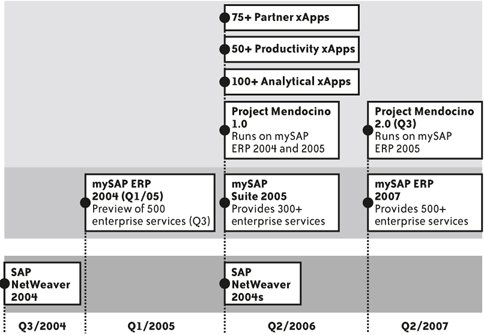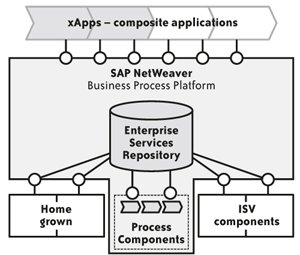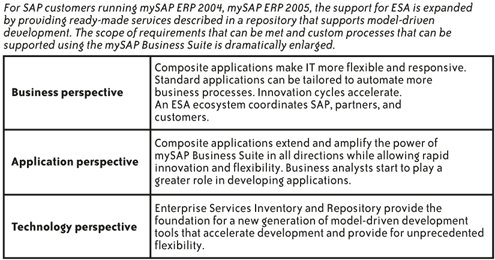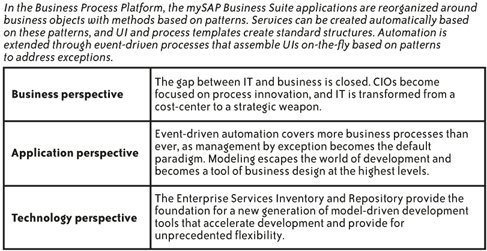Section 1.9. How will the transition to ESA occur?
1.9. How will the transition to ESA occur?ESA is too large a change to happen in a big bang. Over the next few years, each release of the mySAP Business Suite will become increasingly service-enabled, model-driven, pattern-enhanced, and easier to configure and change. At a macro level, the change that ESA will bring will have the following shape:
While the transition described here is oversimplified, it does get to the essence of the change that is taking place. The engine of value creation will be composite applications based on ESA. Application design will change from a process focused on solving one problem to a task centered on assemblingor creating, if neededenterprise services. In essence, the design process will no longer be about how one application supports a process; instead, it will be about how a set of services can be constructed to support many different end-to-end processes implemented by composite applications. (The Enterprise Services Design Guide, available on SDN, is a comprehensive look at this sort of service enablement.) But the shift to this new way of thinking about processes and applications will be incremental, as the three phases just described suggest, as will the implementation of the new applications. To improve our understanding of how ESA will affect enterprise applications, we will explore in more detail the general areas in which ESA will improve applications, and then move on to how ESA will affect the current installed base of SAP applications, how the next releases will change, and how applications will be structured in the long term. Figure 1-15 shows when various ESA-related products will be generally available. Figure 1-15. General availability of selected ESA-related products 1.9.1. ESA's areas of focus for applicationsAs the "What is ESA?" answer explained, ESA affects all levels of the application stack. So, what will be the value? If ESA can improve many things, what will SAP decide to improve first? Figure 1-16 shows the areas on which SAP is focusing. Figure 1-16. ESA overview Here is how ESA will change the application landscape in the long term: SAP will continue to build on xApps composite applications that SAP and ISVs sell as packaged products, and will create even more composite applications to improve user productivity and extend the reach of mySAP Business Suite solutions. (Project Mendocino is an example of this strategy.) Many of these applications will be intended to promote self-service so that employees and managers will be able to perform by themselves the tasks that power users currently perform. Role-based interfaces that walk users through processes step by step will be one of the key ways that productivity is increased. Providing enhanced analytics capabilities will be another major focus that will be satisfied through composite applications that either stand alone or become embedded in mySAP Business Suite solutions. The analytics applications will not only bring together important information about an issue or task but will also allow action to be taken. Many of these new composite applications will be built with modeling tools such as SAP NetWeaver Visual Composer and other modeling environments that allow business analysts to participate in the construction and configuration of composite applications. Composite-application building will be supported by an increasing inventory of enterprise services that the Enterprise Services Repository will describe. The first step in this service enablement was the ESA Preview system on SDN, released in mid-2005. Starting in the first quarter of 2006, the first implementations of services in the Enterprise Services Inventory based on the mySAP Business Suite were released, providing a new gateway for composite application development. The composite applications for the purposes mentioned earlier will use these services, but they will also be available for use by SAP customers and partners, who will be able to use the SAP NetWeaver Developer Studio, the SAP CAF, SAP NetWeaver Visual Composer, and other development techniques to put these services to work or to configure and adapt composite applications created by SAP. As each release of mySAP Business Suite solutions and SAP NetWeaver arrives, the Enterprise Services Inventory will grow and enterprise services will become easier to create. Modeling tools for service composition to create enterprise services will arrive and business objects will start to show up in the mySAP Business Suite solutions that will allow the automatic relation of services that support UI and application patterns. Configuration and administrative functions for applications will be supported with tools for life cycle management. SAP Solution Manager relates high-level business processes to processes automated by applications using a cascading set of models. While the big picture is helpful to know, most companies that use SAP software are interested in how ESA can help them today. The answer depends on where you are starting. 1.9.2. ESA today: SAP R/3Many companies that are running SAP R/3 4.6c think they must upgrade to mySAP ERP 2004 or mySAP ERP 2005 to implement ESA. While more is possible with later versions, SAP customers have made excellent progress on their ESA strategies on SAP R/3 4.6c using the tools and functionality provided by SAP NetWeaver. Figure 1-17 clarifies how enterprise services relate to R/3. Figure 1-17. ESA today: enterprise services and SAP R/3 You can use SAP R/3 4.6c to create composite applications by using the SAP NetWeaver Developer Studio to create web services based in BAPIs and Remote Function Calls (RFCs) in ABAP or in Java. Creation of such web services can be accelerated through the Web Service Infrastructure, which automatically generates proxy code for accessing RFCs, BAPIs, Enterprise JavaBeans? (EJBs), IDOCs, and other interfaces. The SAP NetWeaver Portal or other programs can use these web services. SAP NetWeaver XI can be used to model processes based on web services and other services described in the SAP NetWeaver XI Integration Repository. With SAP R/3 4.6c, ESA is much more a do-it-yourself activity resembling the offerings of tools vendors; if you use these techniques, you can create flexible and powerful composite applications. 1.9.3. ESA in mySAP ERP 2004 and mySAP ERP 2005In mySAP ERP 2004 and mySAP ERP 2005, SAP provides a complete environment for gaining the benefits of ESA. Figure 1-18 explains the relationship of ESA to mySAP ERP 2004 and 2005. Figure 1-18. ESA today: mySAP ERP Composite applications for the purposes mentioned earlier, such as Project Mendocino and self-service, will be provided. The Enterprise Services Repository and Enterprise Services Inventory will be populated. Advanced tools for creating composite applications such as SAP NetWeaver Visual Composer and SAP CAF will become available. With all of this support, companies can start to use these services and development techniques to solve new problems right away. Applying composite applications to the most pressing problems facing a company, as well as to areas in which innovation is important, can increase the quality of IT support for the business and reduce time to market for new ideas. Based on SAP's support for ESA, companies can start the process of cultural change. They can learn to think of their IT infrastructure in ESA terms and build their skills so that increasing value can be created. 1.9.4. ESA in the futureIn future releases of SAP products, the composite application architecture will expand its scope. More and more extensions of mySAP Business Suite solutions will be delivered as composite applications. Parts of the mySAP Business Suite functionality may also become composite applications. Models will become more visible at all levels of development. The complexity of adapting SAP products will be reduced. Many more role-based and industry-specific applications will be supported at an affordable cost. In this world, the differentiator will be the quality of the business vision for automating processes. Companies that gain the vision and skills required to take advantage of ESA will have an important advantage over those that do not. Figure 1-19 describes the future of ESA. Figure 1-19. ESA in the future |
EAN: 2147483647
Pages: 265
- Challenging the Unpredictable: Changeable Order Management Systems
- Enterprise Application Integration: New Solutions for a Solved Problem or a Challenging Research Field?
- Intrinsic and Contextual Data Quality: The Effect of Media and Personal Involvement
- A Hybrid Clustering Technique to Improve Patient Data Quality
- Development of Interactive Web Sites to Enhance Police/Community Relations